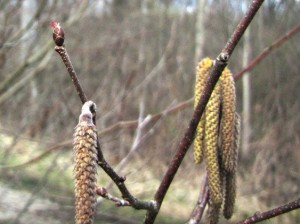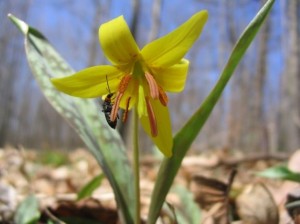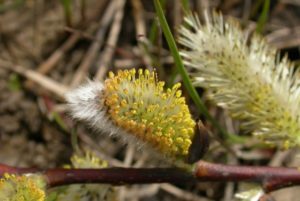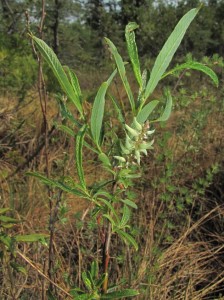YOUR DAILY DOSE OF BOTANY – JANUARY 2014
Monoecious vs. Dioecious
Scott Namestnik, snamestnik@orbisec.com

American Hazelnut (Corylus americana) has both male flowers (yellowish catkins) and female flowers (with reddish stigmas, in top left of photograph) on the same plant
If you’ve spent time using keys to identify plants, it is very likely that you’ve run into road blocks in the form of the words monoecious and dioecious. What do these terms mean?
Most plants have flowers that contain both male parts (stamens) and female parts (pistils). Think of the flowers of a Yellow Trout Lily (Erythronium americanum), for example. When each flower has functional male and female parts, as is the case in Yellow Trout Lily, the flower is said to be perfect. An imperfect flower, then, is one that has either functional male parts (staminate flowers), or functional female parts (pistillate or carpellate flowers), but not both. When a plant has imperfect flowers, they can be arranged in one of two ways. If all of the flowers on a plant are either staminate or pistillate, the plant is said to be dioecious, and the plant is then considered either a reproductively male individual or a reproductively female individual. Willows (Salix spp.) are dioecious, because you will only find staminate or pistillate flowers on an individual plant. On the other hand, if a plant has imperfect flowers, but
both staminate and pistillate flowers are found on the same plant, the plant is said to be monoecious. An example of a genus of monoecious plants is hazelnut (Corylus spp.). One way to remember the difference between monoecious and dioecious plants is to look at the translations of the words monoecious and dioecious. Monoecious” is translated as “single house,” meaning that male and female flowers are found on a single individual. This contrasts with the translation of dioecious, which is “double house.” This means that male flowers are on one plant and female flowers are on another plant.
If you have a question about plant terminology or morphology that you would like answered in a future edition of this column, send me an email at snamestnik@orbisec.com. I may not be able to address all requests given the space allotted for this column, but I will answer those that I can.
Click here to see more of Scott’s informative work
<Back to Your Daily Dose of Botany



